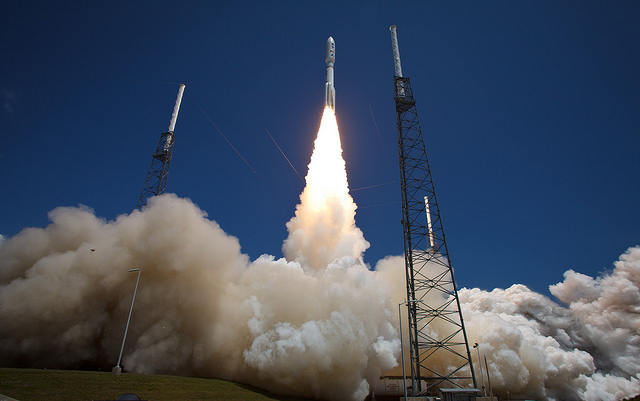

Four different rocket launches were scheduled to take off on Tuesday, and exactly none of those rockets actually took off. Launch delays can cause headaches, but there are good reasons why they happen, and why they’re so common. After all, it’s not wise to get brash about things when your industry revolves around events that cost hundreds of millions of dollars in equipment and workforce, and can be hazardous to people’s safety.
Weather
The biggest reason rocket launches get scrubbed is the weather. If adverse weather is enough to cause delays and cancellations for commercial flights, you can certainly bet it’s enough to scrub a mission worth hundreds of millions of dollars.
And we’re not just talking about extreme conditions. When it comes to space launches, engineers on the ground are monitoring a huge slew of different factors. For NASA’s standards, there can be no precipitation during launch; winds cannot be faster than about 21 mph from the northeast and about 39 mph from other directions; temperatures below 48 degrees Fahrenheit will force a launch scrub since cold weather can cause ice buildup on the rocket or create problems in some of the equipment (the 1986 Challenger explosion that killed seven crew members occurred because the rocket’s rubber O-rings got too cold on the launch pad the night before); and cloud ceilings can’t be lower than 6,000 feet in altitude. NASA even has different procedures for launching through cumulus clouds versus cirrus clouds.
Lightning is one of the biggest concerns for space launches, which makes sense when you’re trying to get a ginormous piece of metal into the air. NASA won’t fuel a rocket if there’s greater than a 20 percent chance of a lightning strike within a five mile radius of the launch site, and won’t launch if lightning is observed within 10 miles of the flight path. That radius also includes the presence of the cloud that produced the lightning. And it just so happens that Central Florida—home to Kennedy Space Center and Cape Canaveral Air Force Station, where much of America’s civilian and private spaceflight operations take place—experiences more lightning strikes than any other place in the U.S. An immense amount of work goes into monitoring electrical field activity, and it’s all to ensure a little spark won’t lead to catastrophe.
NASA itself gathers weather data through a network of ground towers and buoys in the ocean, as well as weather balloons launched hours before liftoff. All of that data is collected right up until the last few seconds before launch, when the cutoff to abort occurs. After that, the flight computers use the data as best they can to determine how to get their rocket to where it needs to go.
And that’s not even taking into account space weather. High levels of high energy particles in near-orbit space are more than enough to force a launch provider to scrub the rocket launch, since space radiation is more than capable of screwing up the electronics onboard.
Mechanical Difficulties
The rocket itself is an engineering marvel whose complexity is on par with the human body, yet much more delicate. A single mechanical issue can threaten the safety of the entire rocket and prevent a mission from making it into space.
For example, improper fueling procedures could create an unintended volatile reaction that creates a combustion (as happened to SpaceX back in 2016). A faulty steel strut meant to secure a canister of helium was the likely cause for the company’s in-flight explosion in 2015. Before Challenger, the most devastating launch-related disaster for NASA was Apollo 1 in 1967, when an electrical fire during a launchpad test claimed the lives of all three crew members.
Up until the last few seconds of any launch, thousands upon thousands of sensors are collecting data to see whether there is anything awry inside the rocket. If any of them detect anything that is too unusual or a sign of concern, they can automatically trigger a scrub, ensuring the safety of the rocket and the payload. And that’s not even considering the importance of integrity checks and maintenance for all of the rocket parts beforehand.
This isn’t just to protect any crew members going into space. It’s also to ensure the safety of engineers and personnel on the ground. The most severe rocket explosion resulting in non-astronaut fatalities was in Alcantara, Brazil in 2003, when the Brazilian Space agency witnessed the detonation of a rocket during launch preparations that killed 21 and injured many more.
The Bizarre
Much more unusual things can also get in the way of a space launch. In 2014, an ISS resupply mission set to launch at NASA’s Wallops Flight Facility was scrubbed after a sailboat—a freaking sailboat!—unwittingly came under the rocket’s flight path about 40 miles from the launch site. If the rocket had taken off and experienced some catastrophic problem, it would have posed a risk to the boat’s passengers. That risk was enough for NASA to scrub the launch for another day.
NASA doesn’t take scrubs lightly. Although numbers for the private industry are harder to come by (and probably lower than what NASA spends), every Space Shuttle launch cancelation after fuel taking had begun cost somewhere around $1.2 million—half a million in fuel losses, and another $700,000 to pay for the extra labor needed to set up an additional launch.
But those costs are a benign price to pay compared to the losses created by months of delays due to a rocket explosion (SpaceX learned that the hard way), or to the loss of life. Truly, the space industry takes the old adage “better safe than sorry” to heights few other industries need to, and that’s a good thing.
